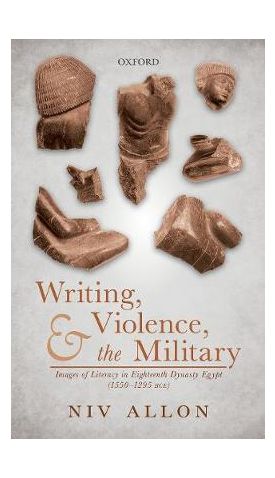אנו משתמשים ב-Cookies כדי לשפר את החוויה שלך. כדי לקיים ההנחיה החדשה של e-Privacy, עלינו לבקש את הסכמתך להגדיר את ה-Cookies. קבלת מידע נוסף.
334.00 ₪
Writing, Violence, and the Military: Images of Literacy in Eighteenth Dynasty Egypt (1550-1295 BCE)
334.00 ₪
ISBN13
9780198841623
יצא לאור ב
Oxford
עמודים
224
פורמט
Hardback
תאריך יציאה לאור
29 באוג׳ 2019
This book takes representations of reading and writing in Eighteenth Dynasty Egypt (ca. 1550-1295 BCE) and explores how patrons of art shaped conceptualizations of literacy in relation to militarism, violence, and memory.
Writing, Violence, and the Military takes representations of reading and writing in Eighteenth Dynasty Egypt (ca. 1550-1295 BCE) as its point of departure, asking how patrons of art conceptualized literacy and how in turn they positioned themselves with respect to it. Exploring statuary and tomb art through the prism of self-representation and group formation, it makes three claims. Firstly, that the elite of this period held a variety of notions regarding
literacy, among which violence and memory are most prominent. Secondly, that among the Eighteenth Dynasty elite, literacy found its strongest advocates among men whose careers brought them to engage with the military, either as military officials or as civil administrators who accompanied the army beyond the
borders of Egypt. Finally, that Haremhab - the General in Chief who later ascended the throne - voiced unique views regarding literacy that arose from his career as an elite military official, and thus from his social world.
Consequently, images of reading and writing allow us to study literacy with regard to those who commissioned them, and to consider these patrons' roles in changing conceptualizations. Throughout their different formulations, these representations call for a discussion on literacy in relation to self-representation and to art's role in society. They also invite us to reconsider our own approach to literacy and its significance in ancient times.
| עמודים | 224 |
|---|---|
| פורמט | Hardback |
| ISBN10 | 0198841620 |
| יצא לאור ב | Oxford |
| תאריך יציאה לאור | 29 באוג׳ 2019 |
| תוכן עניינים | Introduction 1: Writing, Memory, and Violence in the Tomb 2: Prestige and Disdain: Literacy and Self-Representation in the Tomb 3: The Likeness of an Author: The Scribal Statues of Haremhab 4: Palette and Crown: Constructing Haremhab's Royal Literacy Epilogue: Objects, Patrons, and Perceptions |



Login and Registration Form